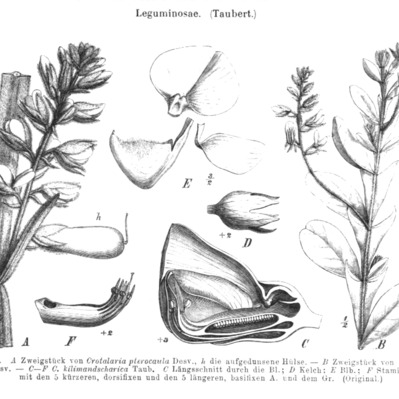Woody herb or small shrub, 1-2.6 m tall, with 1-several thin stems and rather strictly ascending pubescent branches mostly towards the top, rarely somewhat procumbent in burned and heavily grazed places. Leaves mostly in tufts, 3-foliolate; leaflets oblanceolate-linear, oblanceolate to oblanceolate-elliptic, rounded to refuse, mostly (1.5-)2-4.5 x 0.4-1.5 cm, appressed pubescent beneath; petioles usually a little shorter than the leaflets. Stipules shortly stalked, linear-lanceolate to narrowly oblong-falcate, markedly asymmetrical, ±5-15 x 1-4 mm. Racemes terminal, up to 10-22 cm long, with few to many fairly closely to rather laxly arranged flowers; bracts linear to elliptic-caudate, 2.5-6 mm long, caducous; pedicels rather stiffly erect. Calyx 6-9(-10) mm long; upper lobes narrowly attenuate-triangular, as long as to a little longer than the tube. Standard subcircular, yellow, sometimes reddish brown tinged outside, fading orange-red, glabrous outside; wings broad, exceeding the keel; keel abruptly rounded about the middle, with a rather short slightly incurved beak, 1.1-1.4 cm long, lanate towards the upper margin. Legume broadly cylindrical, abruptly contracted to a 4-5 mm long stipe, 3.4-4(-4.5) x 1.1-1.3 cm, glabrous, ±25-40-seeded. Seeds oblong-reniform, 3.5-4 mm long, with a small aril, granulate or smooth, dark brown.
Perennial, woody herb, (0.45-)1.00-2.60 m high, with 1-several thin, strictly ascending stems. Leaves mostly in tufts. Leaflets ± oblanceolate, appressed-pubescent beneath. Inflorescences up to 0.1-0.2 m long racemes, terminal. Flowers yellow, sometimes reddish brown-tinged. Calyx with lobes ± the same length as tube. Petals: wings exceeding keel; keel abruptly rounded about the middle with a short incurved beak. Pod widely cylindrical, abruptly contracted to a stipe, 34-45 mm long, glabrous, 25-40-seeded. Seeds oblong reniform, with small aril, granulate or smooth, dark brown.
An erect herb or shrub. It grows 40-50 cm high. The branches are straight. They are covered with fine hairs. The leaves have 3 leaflets. The leaves are 2.5 cm long. The flowers are brownish-yellow. They are in groups of 5-10 at the ends of branches. The fruit are fattened pods 3.5 cm long and 1.3 cm wide.
Leaves mostly in tufts, 3-foliolate; leaflets mostly (1.5)2–4.5 × 0.4–1.5 cm, linear-oblanceolate to oblanceolate-elliptic, appressed pubescent beneath; petioles mostly a little shorter than leaflets; stipules (3)5–15 × 1–4 mm, shortly stalked, linear-lanceolate to oblong-falcate, very unequal-sided.
Standard subcircular, yellow, sometimes reddish-brown tinged outside, fading orange-red, glabrous outside; wings broad, exceeding the keel; keel 11–14 mm long, abruptly rounded about the middle, with a rather short slightly incurved beak, lanate towards the upper margin.
Woody herb or small shrub, 1–2.6 m tall, with 1–several thin stems and rather strictly ascending pubescent branches mostly towards the top, rarely somewhat procumbent in burned and heavily grazed places.
Racemes terminal, up to 10–22 cm long, with few–many fairly closely to rather laxly arranged flowers; bracts 2.5–6 mm long, linear to elliptic-caudate, caducous; pedicels rather stiffly erect.
Pod 3.4–4(4.5) × 1.1–1.5 cm, broadly cylindrical, abruptly contracted to a 4–5 mm long stipe, glabrous, often mottled dark green to blue-black before ripening, 25–40-seeded.
Calyx 6–9(10) mm long; upper lobes narrowly attenuate-triangular, as long as to a little longer than the tube.
Seeds 3.5–4 mm long, oblong-reniform, with a small aril, granulate or smooth, dark brown.

